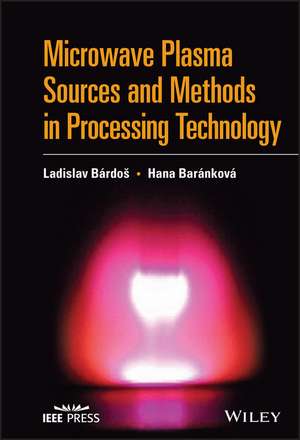Microwave Plasma Sources and Methods in Processing Technology
Autor Bardosen Limba Engleză Hardback – 3 mar 2022
A practical introduction to microwave plasma for processing applications at a variety of pressures
In Microwave Plasma Sources and Methods in Processing Technology, an award-winning team of researchers delivers a comprehensive introduction to microwaves and microwave-generated plasmas. Ideal for anyone interested in non-thermal gas discharge plasmas and their applications, the book includes detailed descriptions, explanations, and practical guidance for the study and use of microwave power, microwave components, plasma, and plasma generation.
This reference includes over 130 full-color diagrams to illustrate the concepts discussed within. The distinguished authors discuss the plasmas generated at different levels of power, as well as their applications at reduced, atmospheric and higher pressures. They also describe plasmas inside liquids and plasma interactions with combustion flames.
Microwave Plasma Sources and Methods in Processing Technology concludes with an incisive exploration of new trends in the study and application of microwave discharges, offering promising new areas of study.
The book also includes:
- A thorough introduction to the basic principles of microwave techniques and power systems, including a history of the technology, microwave generators, waveguides, and wave propagation
- A comprehensive exploration of the fundamentals of the physics of gas discharge plasmas, including plasma generation, Townsend coefficients, and the Paschen curve
- Practical discussions of the interaction between plasmas and solid surfaces and gases, including PVD, PE CVD, oxidation, sputtering, evaporation, dry etching, surface activation, and cleaning
- In-depth examinations of microwave plasma systems for plasma processing at varied parameters
Perfect for researchers and engineers in the microwave community, as well as those who work with plasma applications, Microwave Plasma Sources and Methods in Processing Technology will also earn a place in the libraries of graduate and PhD students studying engineering physics, microwave engineering, and plasmas.
Preț: 892.07 lei
Preț vechi: 980.29 lei
-9% Nou
170.73€ • 177.56$ • 142.87£
Carte tipărită la comandă
Livrare economică 14-28 martie
Specificații
ISBN-10: 111982687X
Pagini: 208
Dimensiuni: 152 x 229 x 13 mm
Greutate: 0.45 kg
Editura: Wiley
Locul publicării:Hoboken, United States
Cuprins
Notă biografică
Ladislav Bárdoa is Professor at the Department of Electrical Engineering at Uppsala University. He received his PhD from the Institute of Plasma Physics at the Czech Academy of Sciences in 1978 and DrSc from the Charles University Prague in 1995. He was awarded the Plasma Physics Innovation Prize 2019 by the European Physical Society. Hana Baránková is Professor at the Department of Electrical Engineering, Uppsala University. She received her PhD from the Institute of Radio Engineering and Electronics at the Czech Academy of Sciences in 1981. She was awarded the Plasma Physics Innovation Prize 2019 by the European Physical Society. She is Secretary of the Board of Directors at the Society of Vacuum Coaters in the US.
